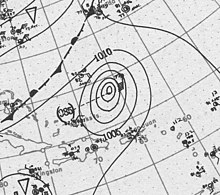|name=. Remove this parameter; the article title is used as the name by default. Surface weather analysis of the hurricane moving north in the Sargasso Sea on October 11 | |
| Meteorological history | |
|---|---|
| Formed | October 6, 1916 |
| Dissipated | October 15, 1916 |
| Category 3 major hurricane | |
| 1-minute sustained (SSHWS/NWS) | |
| Highest winds | 120 mph (195 km/h) |
| Lowest pressure | 963 mbar (hPa); 28.44 inHg (Lowest directly measured[note 1]) |
| Overall effects | |
| Fatalities | 41 total |
| Damage | <$2 million (1916 USD) |
| Areas affected | |
| [3] | |
Part of the 1916 Atlantic hurricane season | |
The 1916 Virgin Islands hurricane was a strong tropical cyclone that inflicted extensive damage across the Virgin Islands in October 1916. It was the region's most destructive storm since at least the 1867 San Narciso hurricane; Consul General Christopher Payne and archaeologist Theodoor de Booy considered the 1916 storm as the archipelago's most damaging. Its peak intensity was equivalent to a Category 3 on the modern Saffir–Simpson scale. The storm began as a tropical depression southeast of Barbados on October 6, though little is known about the storm's origins or its developing stages; by the time its center was first located, the cyclone was already a hurricane and causing damage in the Virgin Islands. After forming, the storm moved northwest into the eastern Caribbean Sea and strengthened quickly. Rough seas were produced in the Windward Islands at Dominica and Saint Kitts as the storm passed nearby between October 7–8, damaging coastal villages.
On the evening of October 9, the hurricane traversed the Virgin Islands with an intensity equivalent to a Category 2 on the modern Saffir–Simpson scale, passing directly over Saint Croix and producing gusts as high as 160 mph (260 km/h). Of the Danish West Indies, Saint Thomas fared worst, with virtually every building sustaining damage. The island harbor suffered greatly and numerous ships were grounded or sunk. Entire towns in Saint Croix and Tortola were destroyed. There were four deaths in Saint Thomas, five in the remainder of the Danish West Indies, and thirty-two in Tortola. After battering the Lesser Antilles, the hurricane continued harmlessly out to sea on a northward and later northeastward trajectory. While well southeast of Bermuda, the storm's intensity peaked on October 12 with maximum sustained winds of 120 mph (190 km/h). Steady weakening ensued thereafter, and the storm transitioned into an extratropical cyclone on October 14 before being absorbed by another cyclone east of Newfoundland a day later. Amid the storm's aftermath, coal carriers successfully went on strike for increased wages. Crop production in 1917 was significantly curtailed by the widespread damage wrought to agriculture by the hurricane.
- ^ a b "Atlantic hurricane best track (HURDAT version 2)" (Database). United States National Hurricane Center. April 5, 2023. Retrieved October 11, 2024.
 This article incorporates text from this source, which is in the public domain.
This article incorporates text from this source, which is in the public domain.
- ^ Landsea, Chris; Anderson, Craig; Bredemeyer, William; Carrasco, Cristina; Charles, Noel; Chenoweth, Michael; Clark, Gil; Delgado, Sandy; Dunion, Jason; Ellis, Ryan; Fernandez-Partagas, Jose; Feuer, Steve; Gamanche, John; Glenn, David; Hagen, Andrew; Hufstetler, Lyle; Mock, Cary; Neumann, Charlie; Perez Suarez, Ramon; Prieto, Ricardo; Sanchez-Sesma, Jorge; Santiago, Adrian; Sims, Jamese; Thomas, Donna; Lenworth, Woolcock; Zimmer, Mark (May 2015). "Documentation of Atlantic Tropical Cyclones Changes in HURDAT". Atlantic Oceanographic and Meteorological Laboratory (Metadata). Miami, Florida: National Oceanic and Atmospheric Administration. 1916/13 - 2008 Revision. Retrieved March 23, 2020.
- ^ group = note
Cite error: There are <ref group=note> tags on this page, but the references will not show without a {{reflist|group=note}} template (see the help page).